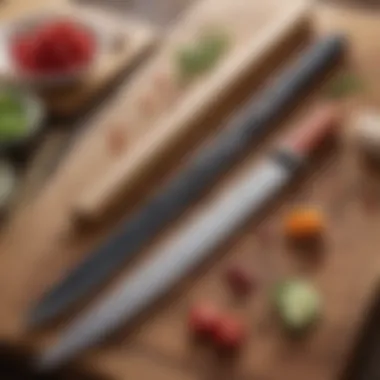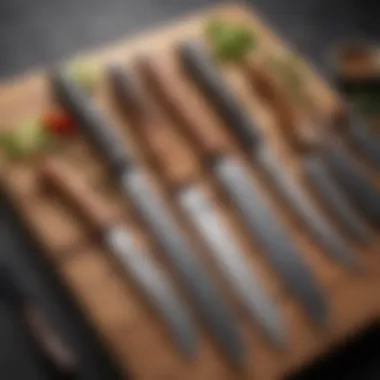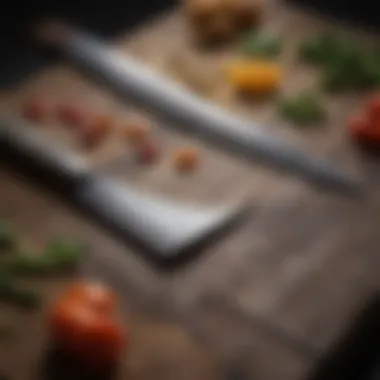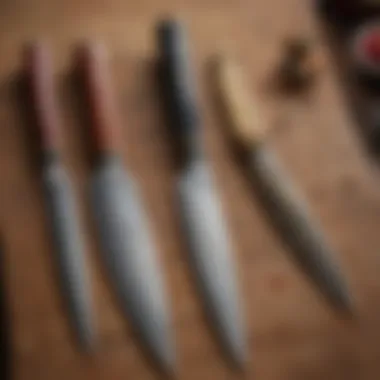Exploring Premium Japanese Chef Knives for Culinary Mastery


Intro
Japanese style chef knives, revered for their precision and sharpness, are essential tools in any kitchen. Their design often mirrors the rich culinary traditions of Japan, showcasing both functionality and artistry. Understanding the unique features of these knives can unlock a better cooking experience, enhancing both preparation efficiency and dish presentation.
Several factors contribute to the appeal of Japanese chef knives. Their craftsmanship, often reflecting centuries of metalworking traditions, results in blades that are not just functional but aesthetically pleasing. The materials used in their manufacture, including high-carbon steel and various alloys, play a critical role in their performance. Additionally, the ergonomic designs underscore a focus on usability, making them a favorite among professional chefs and cooking enthusiasts alike.
In this article, we will explore the fundamental aspects of Japanese style chef knives, including their key characteristics, material compositions, and suitable applications in culinary practices. We will also cover how to choose the right knife for different tasks, provide advice on care and maintenance, and discuss notable knife brands that are recognized for their high quality. By synthesizing this information, both novice cooks and seasoned professionals can make informed decisions regarding their knife selection, ultimately enhancing their overall culinary experience.
Prelude to Japanese Chef Knives
Japanese chef knives are not just tools; they embody a rich tradition of craftsmanship and precision in the kitchen. In this section, we will explore why understanding Japanese chef knives is crucial for anyone serious about cooking. These knives are distinct in their design, functionality, and cultural heritage, which influence their performance and the overall cooking experience.
One of the primary benefits of a Japanese chef knife lies in its superior steel quality and balance. Many knives are crafted using high-carbon steel that offers sharpness and durability. This unique blend of materials allows for cleaner cuts and less resistance when slicing. Such characteristics make Japanese knives preferable for both professional chefs and home cooks.
In addition to practical considerations, it is important to appreciate the historical context and cultural significance of these knives. Their origins can be traced back centuries, where the techniques and skills have been passed down through generations. This history not only adds depth to the experience of using these knives but also instills a sense of respect for the art of Japanese culinary practices.
Moreover, selecting the right Japanese chef knife can elevate one's cooking by facilitating various tasks with ease. From slicing delicate fish to dicing vegetables, each type of knife serves a specific purpose, ensuring efficiency and precision.
In summary, an understanding of Japanese chef knives goes beyond mere functionality. It includes appreciating the craftsmanship, history, and cultural context that comes with these exceptional tools. As we delve deeper into the nuances of Japanese knives, we can recognize their pivotal role in elevating culinary practices and enhancing the cooking experience.
Historical Context
The evolution of Japanese chef knives can be traced to the samurai era, where sword-making expertise was crucial. Artisans, known as tōkushi, began applying their skills to create kitchen knives. The forge techniques used for katana swords were adapted for chef knives, resulting in blades that are both sharp and resilient. Originally, these knives were designed for specific tasks related to food preparation, hinting at their practical origins.
Through the Meiji period, as Japan opened its borders to the world, there was a growing interaction with Western cooking styles. This period saw the emergence of new designs in Japanese knives that blended traditional craftsmanship with modern requirements. The craftsmanship remained deeply influential, where skilled artisans often spent years honing their skills to create a well-balanced knife. The rich heritage of knife-making continues to impact contemporary designs.
Cultural Significance
Japanese knives do not merely serve as functional kitchen tools; they are a reflection of the culture and philosophy behind Japanese culinary arts. The meticulous attention to detail and the emphasis on harmony in design resonate in every aspect of crafting these knives. Each knife carries a story, embodying principles that speak to the values of precision and respect for ingredients.
Additionally, the cultural practice of using these knives incorporates spiritual elements. For many chefs, investing in a high-quality knife symbolizes a commitment to their craft. Knives are often passed down through generations, signifying the importance of tradition in Japanese cooking. This connection to lineage and heritage elevates the experience of using these tools in one's own cooking practices.
In essence, the historical background and cultural significance of Japanese chef knives enrich their value far beyond their everyday use. They serve as reminders of the skilled artistry and profound appreciation for food that is deeply rooted in Japanese culture.
Types of Japanese Chef Knives
Understanding the different types of Japanese chef knives is crucial for anyone keen on enhancing their kitchen skills. Each knife serves a distinct purpose and brings unique benefits that cater to various culinary tasks. When selecting a knife, it is important to consider factors such as the shape, length, and intended use. Focusing on these elements ensures that cooks can perform tasks efficiently with precision and ease.
Gyuto
The Gyuto knife is arguably the most versatile knife in Japanese kitchens, comparable to the Western chef's knife. Its blade typically ranges from 210 mm to 300 mm, making it suitable for almost any cutting task. Cooks appreciate its pointed tip for precise slicing and its broad blade for tasks such as chopping or mincing.
"The Gyuto knife's adaptability makes it a favorite among both professional chefs and home cooks alike."
Its versatile design allows users to perform multiple functions, from dicing meat and fish to chopping vegetables. The Gyuto's edge is usually thinner compared to Western knives, offering finer cuts with less effort. This quality is ideal for chefs who value both efficiency and craftsmanship in their tools.
Santoku
The Santoku knife, which translates to "three virtues," signifies its efficiency in slicing, dicing, and mincing. Generally, it has a shorter blade than the Gyuto, usually between 165 mm and 210 mm. This makes it excellent for general-purpose cooking and an ideal choice for those who may feel overwhelmed by larger knives.
The distinctive Granton edge, characterized by small indentations along the blade, helps food to slide off easily. This unique feature minimizes sticking, allowing for smooth and consistent cutting. The Santoku is popular not only among seasoned chefs but also among beginners due to its accessibility and ease of use.
Nakiri
The Nakiri knife is specifically designed for vegetable preparation. Its straight blade allows for precise and clean cuts, making it perfect for anyone who often slices or dices vegetables. With a blade length that typically falls between 165 mm to 210 mm, the Nakiri provides excellent control and balance.
One of the key advantages of the Nakiri is its ability to perform a chopping motion, which is essential for many vegetable dishes. The flat edge ensures that the entire blade makes contact with the cutting board. This feature maximizes efficiency, enabling cooks to prepare ingredients quickly and with minimal effort.
Suji Hiki
The Suji Hiki knife is a slicing knife tailored for meat, fish, and poultry. With a long, narrow blade that typically ranges from 240 mm to 300 mm, this knife excels at long, fluid cuts. The thin edge enables users to achieve beautifully sliced pieces without tearing the flesh.


Chefs often turn to the Suji Hiki for its precision and elegance during plating. Whether it’s sashimi or carving a roast, this knife is indispensable in achieving professional-grade presentations. Its lightweight design and balance make it a popular choice among those who prioritize finesse in their culinary creations.
Key Features of Japanese Style Knives
The realm of Japanese chef knives is a world defined by precision, quality, and craftsmanship. Understanding the key features of these knives is essential for any serious cook. These features go beyond mere aesthetics; they impact performance, usability, and overall satisfaction in cooking.
Blade Construction
Blade construction is crucial as it determines not only the knife's cutting ability but also its durability and maintenance. Here are the three main aspects:
Types of Steel
The type of steel used in Japanese chef knives is critically important. High-carbon stainless steel is a common choice because it offers a balance of hardness and corrosion resistance. This steel is essential for providing the sharp edge needed in culinary tasks. Additionally, Japanese knives may also use a specialized steel like VG-10, which is renowned for its edge retention and easy sharpening properties. One unique feature of this steel is its wear resistance, which allows the knife to maintain its sharpness longer than ordinary steels.
Hardness Levels
Hardness levels measured on the Rockwell scale affect how well a knife holds its edge under stress. Most Japanese knives range from 61-64 HRC, providing an ideal edge that allows for precise cuts without excessive chipping. This high hardness is a significant benefit, as it retains sharpness significantly longer compared to knives with lower hardness. However, the trade-off is that harder blades can be more prone to becoming brittle if mishandled.
Layering Techniques
Layering techniques, such as those seen in the production of Damascus steel, add functionality and beauty to knives. This method involves folding different layers of steel together, creating a blade that is both resilient and visually stunning. The multiple layers offer advantages such as increased strength and improved sharpness. The unique feature of layering is that it not only enhances the knife's performance but also contributes to its aesthetic appeal, making every knife a piece of art.
Handle Design
The handle design of a knife influences how comfortably and effectively it can be used. This aspect often requires careful consideration to match the user’s preferences and cooking style. Here’s what to focus on:
Materials Used
The material of the handle is critical for comfort and durability. Many high-end Japanese knives feature handles made from woods like Ho or Pakka, which provide excellent grip and endure moisture well. The choice of material directly contributes to the overall feel of the knife during extended use. Wooden handles often provide a warm, traditional feel, while synthetic handles might offer enhanced durability and maintenance ease.
Ergonomics
Ergonomics play a vital role in the usability of a knife. A well-designed ergonomic handle allows for a natural hand position, reducing fatigue during long cooking sessions. This characteristic is essential for cooks who spend hours in the kitchen. The unique advantage is that it creates a more controlled and confident grip, enhancing cutting accuracy while minimizing the risk of injury.
Aesthetics
The visual appeal of a Japanese knife can be undeniably captivating. Aesthetics is not just about looks; it contributes to the overall value of the knife. Intricate designs, such as the finish or custom engravings, can elevate a knife from a tool to a cherished piece. The unique feature here lies in the fact that a beautifully designed knife can inspire and enhance the cooking experience, making it more enjoyable and fulfilling.
Weight and Balance
Weight and balance are often overlooked but crucial characteristics in the performance of a knife. The overall weight affects how the knife feels in the hand, while balance ensures that it is easy to control during use. A well-balanced knife reduces strain on the wrist, allowing for prolonged usage without discomfort. The aim is to find a knife that feels natural and stable when cutting.
A well-crafted Japanese knife is more than just a kitchen tool; it's an extension of the chef's hand.
By understanding the key features of Japanese knives, chefs can make informed choices that align with their culinary needs. Each characteristic contributes to a knife's ability, making it a necessary factor in enhancing both the enjoyment and effectiveness of cooking.
Handmade vs. Mass-Produced Knives
The distinction between handmade and mass-produced knives is vital in understanding the spectrum of Japanese chef knives available today. Each approach to knife-making carries unique attributes that appeal to different users, from professional chefs to home cooks. The decision to choose between these two styles can greatly affect not just performance but also the culinary experience itself.
Artisanal Craftsmanship
Techniques Employed
In the world of handmade knives, artisanal craftsmanship stands out as a central tenet. Techniques such as forging by hand, where skilled artisans shape the steel over heat, contribute significantly to the blade's performance and aesthetics. The process of hand-forging allows for greater control over the blade's properties, creating a unique edge and feel. Each knife becomes a one-of-a-kind creation, showcasing the artisan's expertise.
This attention to detail results in blades that often retain their sharpness longer than mass-produced counterparts. Additionally, many artisans use a differential hardening technique, which produces a blade that is hard at the edge while remaining softer at the spine. This unique feature provides a balance between sharpness and durability, making handmade knives a beneficial choice for serious culinary tasks. However, this method can also make these knives more expensive due to the labor-intensive production process.
Longevity and Performance
Longevity and performance are two defining characteristics of handcrafted knives. A handmade knife, built through traditional techniques, often demonstrates resilience under regular use. The high-carbon steels used are typically treated to enhance their toughness. This resistence to wear ensures that users can rely on their knives for years without significant degradation.
The performance of a handmade knife often provides joy to the user during culinary activities. Its superior balance and weight distribution can lead to more precise cuts, enhancing overall cooking efficiency. Being designed for longevity, these knives often come with fewer concerns about needing replacement or extensive repairs. However, they require proper maintenance, which can be a disadvantage for those unfamiliar with such care.


Manufacturing Processes
Mass-produced knives rely on automated manufacturing processes, resulting in higher consistency in terms of size and shape. However, this method can sacrifice some of the tailored performance found in handmade options. The knives often use stamped or ground blades rather than hand-forging, which may yield a different feel when cutting. While most offer good performance, they may not match the discerning standards of serious chefs who seek extreme precision.
Price Considerations
When considering price, handmade knives typically command a premium. Their unique features, extensive labor, and the expertise required in their creation contribute to higher costs. Meanwhile, mass-produced knives are generally more affordable and accessible, making them a common choice for beginner cooks or those on a tight budget.
Choosing the right knife involves evaluating quality versus cost. Investing in a reliable handmade knife can enhance cooking over the years, while mass-produced options may suffice for less demanding kitchen tasks.
Selecting the Right Japanese Chef Knife
Choosing the right Japanese chef knife is a critical element for anyone looking to enhance their skills in the kitchen. The unique construction, materials, and designs of these knives can significantly affect food preparation. Selecting the right knife not only influences the ease of cutting but also impacts the quality of the dish. Understanding different aspects, like culinary needs, size, and budget constraints, can guide a cook in making an informed decision.
Maintenance and Care of Japanese Knives
Caring for Japanese knives is vital to preserve their unique attributes and longevity. These knives are typically crafted from high-quality steel, making them sharp and precise. However, without proper maintenance, even the finest knife can lose its edge. It is essential to incorporate regular care routines to ensure optimal performance and durability. This section delves into various methods for maintaining your knives, focusing on sharpening, cleaning, storage, and debunking common misconceptions.
Sharpening Techniques
Whetstones
Whetstones are a popular tool for sharpening Japanese knives. They provide a controlled and effective way to maintain the edge. A whetstone typically contains abrasive materials, which wear down the steel to create a sharper blade. The key characteristic of whetstones is their versatility. They come in various grits, allowing users to refine their knives from coarse to fine finishing. This adaptability makes them a preferred choice in maintaining the sharpness of Japanese knives.
A unique feature of whetstones is their ability to sharpen the knife without excessively grinding down the blade. This makes them advantageous for long-term care. However, they require skill and practice to use effectively, which may present challenges for novice cooks. Still, for those willing to learn, the results can be remarkably beneficial.
Professional Services
Professional sharpening services offer an alternative to personal sharpening. These services usually employ advanced techniques and tools to achieve precise results. The key characteristic of professional services is their expertise. Professionals have extensive experience and knowledge in handling various types of knives. This makes them a reliable choice for individuals who prefer a non-hands-on approach to knife care.
A unique feature of professional sharpening is the ability to handle intricate repairs, such as fixing chips or reshaping blades. This offers an advantage if your knife has sustained damage beyond regular dullness. However, the downside is financial; these services can become costly over time. It’s important to weigh the benefits against the potential expense according to your usage frequency.
Cleaning and Storage
Best Practices
Proper cleaning practices are crucial in maintaining the integrity and appearance of Japanese knives. The best practice is to wash knives immediately after use with warm water and gentle soap. This prevents food residue from hardening on the blade. The key characteristic of these best practices is the emphasis on gentle handling.
Using abrasive sponges or harsh cleaning agents can damage the blade or handle. This careful approach makes such methods beneficial for preserving the knife's quality. Additionally, drying the knife immediately with a soft cloth prevents rust and corrosion, which are common concerns.
Storage Solutions
Storing Japanese knives appropriately is equally important. Many people opt for wooden blocks or magnetic strips, as these options prevent the blades from coming into contact with other metallic surfaces. The key characteristic of such storage solutions is their ability to keep knives organized and safe. This keeps the edge sharper for longer periods.
One unique feature of magnetic strips is that they allow for easy access and viewing of your knife collection. However, it is essential to mount them securely to avoid accidents. The downside of wooden blocks can be the lack of ventilation, which may lead to moisture retention. Thus, choosing the right solution is essential for effective knife care.
Common Misconceptions
Many misconceptions surround the maintenance of Japanese knives. One common belief is that they can be washed in a dishwasher. This is a major mistake, as the heat and moisture can cause the handles to warp and the steel to rust.
Another misconception is that sharpening should only be done when the blade feels dull. In reality, frequent light sharpening will prolong the knife's life and maintain its performance. Understanding these misconceptions is critical to effective knife care and will help enhance the overall cooking experience.
Top Brands of Japanese Chef Knives
When exploring Japanese chef knives, the discussion about top brands emerges as a vital part of the narrative. The knives from established brands often embody a combination of tradition and modern innovation. Their reputation can provide insight into quality, craftsmanship, and performance.
For culinary enthusiasts and professionals alike, choosing a knife from a recognized brand can significantly reduce the risk of making a poor purchase. These brands not only invest in superior materials but also uphold refined manufacturing processes. Many of them are rooted in centuries of craftsmanship, guaranteeing that each knife is not just a tool but an extension of the chef's hand.
Global Recognition
In the sphere of culinary tools, certain brands have gained global acknowledgment for their outstanding quality. For instance, brands like Shun and Global have become synonymous with exceptional knife performance.


Shun, known for their high-quality Damascus steel, offers knives that are both beautiful and razor-sharp. They are often favored for their stunning finish and precise cutting abilities, making them a staple in professional kitchens and among serious home cooks.
Global knives, originating from Japan, are widely known for their unique design and use of high-carbon stainless steel, allowing for lightweight yet durable knives. Their distinctive look and ergonomic design enhance user comfort, appealing to many chefs.
This global recognition is not merely for marketing; it reflects the brands' commitment to quality, which translates to longevity in performance and user satisfaction. Acknowledged brands frequently participate in international culinary competitions, which further cements their reputation across the culinary community.
Emerging Brands
While traditional brands dominate the market, several emerging companies also deserve attention. These newer brands often bring fresh perspectives and innovations to the industry. They frequently focus on niche segments, utilizing unique production techniques or materials.
For example, brands like Tojiro are gaining traction by offering high-quality knives at accessible prices. Their range appeals to both novice cooks and veterans looking to try something without breaking the bank.
Another notable name is Sakai Takayuki, which blends age-old techniques with modern aesthetics. They are redefining perceptions of Japanese knives and attracting a younger audience eager for quality at an affordable rate.
Investing in knives from emerging brands can offer surprising value while also supporting the ongoing evolution of culinary tools. As these companies evolve and gain a foothold in the market, they challenge established norms and create new definitions of quality and design in knife-making.
"The future of kitchen tools lies not only in the hands of renowned brands but also in the innovation and passion of new entrants in the market."
In summary, the top brands of Japanese chef knives, whether globally recognized or newly emerging, contribute significantly to the overall understanding and appreciation of Japanese culinary culture. Their influence helps define what quality means in modern cooking, influencing the tools that chefs choose for their craft.
Comparing Japanese Knives with Western Styles
Understanding the distinctions between Japanese and Western knives is essential for anyone keen on culinary arts. This comparison not only highlights design and usability differences but also their respective applications in various cooking techniques. By examining these differences, cooks can identify which style best suits their needs.
Design Differences
The desing of Japanese knives is often characterized by a thinner blade along with a sharper edge. They typically feature a flatter profile, which allows for a more precise cutting motion. In contrast, Western chef knives like the classic Wüsthof or the Victorinox employ a broader blade, equipped with a curved edge suited for rocking motions while chopping.
Additionally, Japanese knives often focus on a single beveled edge, resulting in a sharper and more acute angle. This single bevel increases cutting precision. Conversely, Western knives use a double bevel, which provides more versatility for different cutting techniques but may not achieve the same level of sharpness.
Usability
Usability between the two styles varies based on personal preference and cooking habits. Japanese knives tend to be lighter and more nimble, ideal for delicate tasks, like slicing fish for sushi. Many chefs find them easier to maneuver, providing a level of control that can elevate the quality of their work. However, the lighter design may sacrifice some durability, requiring careful handling.
Western knives, with their sturdier build, often excel in tasks requiring more force, like cutting through denser materials. They are generally perceived as easier for beginners to handle, as they are forgiving and versatile. The weight and balanced feel of a Western knife can also provide a sense of confidence when chopping.
Culinary Applications
When comparing culinary applications, Japanese knives shine in tasks demanding precision, such as fine slicing, dicing, and finesse cuts. Their specific designs cater to tasks like filleting fish, making them the preferred choice in Japanese cuisine. On the other hand, Western knives are often favored for their multi-functional usability; they are effective in various kitchen tasks, such as chopping vegetables, breaking down poultry, or even handling larger cuts of meat.
Some key applications include:
- Japanese Knives:
- Western Knives:
- Sushi and sashimi preparation
- Vegetable slicing, especially in Asian cuisines
- Fine butchery tasks
- General kitchen tasks (dicing, mincing)
- Grinding and chopping herbs
- Preparing large cuts of meat or poultry
"Understanding the differences between Japanese and Western knives can enhance one's cooking experience and improve the quality of the dishes prepared."
Choosing between these knife styles ultimately comes down to personal cooking preferences. Knowing how each knife performs can make a considerable impact on the culinary tasks one seeks to accomplish.
Finale
The conclusion serves a vital purpose in summarizing the insights presented throughout the article. It is a moment of reflection that synthesizes information about Japanese style chef knives, reinforcing their significance in culinary practice. When a reader finishes this article, they should have a clear understanding of how the unique features of Japanese knives can elevate cooking experiences.
Japanese knives are not just tools; they embody tradition, precision, and care. This closing section highlights their characteristics and craftsmanship, allowing cooks to appreciate the nuances that distinguish these knives from others. Understanding these aspects is not only informative but also encourages a deeper connection to the art of cooking.
Recap of Key Points
- History and Culture: Japanese chef knives are rich in history and cultural significance, showcasing centuries of craftsmanship.
- Types and Features: Different types of knives, such as Gyuto and Santoku, each serve unique purposes, highlighting the diversity in Japanese knife design.
- Handmade vs. Mass-Produced: The artisanal techniques employed in handmade knives provide better longevity and performance compared to mass-produced options.
- Selection and Care: Selecting the right knife involves assessing culinary needs and understanding proper maintenance to preserve quality.
- Comparison with Western Knives: The design and usability differences between Japanese and Western style knives showcase distinct approaches to culinary tasks.
The Role of Japanese Knives in Modern Cooking
Japanese knives have retained their relevance in contemporary kitchens, merging tradition with modern culinary needs. Their sharpness, balance, and ease of use enable chefs and home cooks alike to tackle tasks efficiently. The intricate craftsmanship ensures that these knives are not only durable but also capable of delivering precise cuts.
As food trends evolve, the demand for high-quality knives continues to grow. Culinary enthusiasts appreciate how Japanese knives enhance techniques like slicing, dicing, and julienning. Moreover, the aesthetic appeal of these knives contributes to their status as cherished tools, often becoming a focal point in kitchen design.
In summary, the enduring legacy of Japanese chef knives lies in their ability to blend functionality with artistry. They serve as instruments that not only assist in food preparation but also elevate the cooking experience itself.













